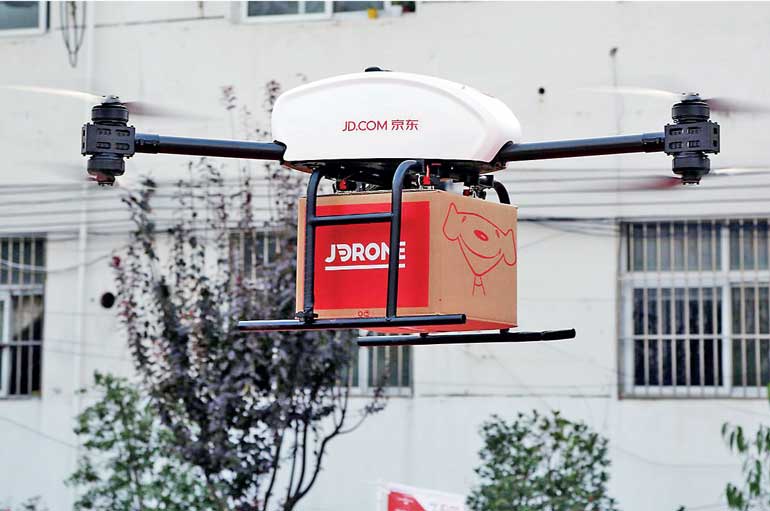Sunday Apr 20, 2025
Sunday Apr 20, 2025
Friday, 2 March 2018 00:00 - - {{hitsCtrl.values.hits}}
 “Rural deliveries in China aren’t easy,” says Yang Guoping, a village postman in Hanggai Township, Anji County, east China’s Zhejiang Province, since 1992. He rises early, has a quick breakfast and pedals several hours from the post office in the town center to remote villages, bringing parcels, letters and newspapers.
“Rural deliveries in China aren’t easy,” says Yang Guoping, a village postman in Hanggai Township, Anji County, east China’s Zhejiang Province, since 1992. He rises early, has a quick breakfast and pedals several hours from the post office in the town center to remote villages, bringing parcels, letters and newspapers.
His routes, many kilometers long, are mainly rugged and narrow mountain roads, linking every village like blood vessels. Yang often falls in the rain or snow.
One of his colleagues resigned last year, leaving Hanggai Township – population about 36,000 – with just three village postmen.
As well as having complex terrain and underdeveloped infrastructure, rural China is often sparsely populated and Yang can reach remote villages just twice a week.
China Post was considering ways to improve rural deliveries when it discovered unmanned aerial vehicles could do the job. In April 2016, it began cooperating with drone maker Antwork.
Five months later, the startup based in Hangzhou, capital of Zhejiang Province, developed a drone delivery operating system named JetGo, and soon deployed it in Hanggai.
Company founder Zhang Lei, who graduated from Beihang University with a major in flight vehicle design and engineering, says the most cost-efficient delivery is “nature’s path” - the air.”The air is a path that requires no human effort.”
A postman at a township delivery depot puts a battery in a drone and loads it with parcels before inputting the destination on an app and scanning a QR code. Staff at the control center then check weather forecasts and inspect the machine online before letting it take off.
Meanwhile, the heads of recipient villages receive a delivery notice on their cell phones, telling them to place a visual marker on the ground as the landing spot.
The drones can carry five to seven kg and fly 30 km, making the journey in less than 20 minutes. In the past, it would take a postman two hours for one delivery.
The drone service also costs less. Yang calculates a human courier usually costs 90 yuan a day, but each drone delivery is about 35 yuan. The company sells each drone for 100,000 yuan.
Zhang says his company has made technical improvements to curb risks like losing signals in mountain areas. The biggest challenge is finding the right landing spots. In hundreds of trial deliveries, the drones landed on roofs or tree tops.
Zhang’s solution was to use sonar, laser and infrared sensors to help determine heights and avoid obstacles in real time.
“Sensors complement the operating system and increase the reliability of the machine,” says Zhang. “They’re like our eyes, ears and nose. Each may not be 100% reliable, but if we use them together, we will not fall when dust gets in our eyes.”
Drone services have expanded in provinces including Guangdong, Sichuan, and Guizhou, where rural transportation is difficult. Zhang says his drones have delivered parcels to more than 100 villages.
In some areas, they deliver five or six times a day.
Zhang has also pioneered drone delivery to hotels and guesthouses in rural areas to “serve urban travelers”.
Many Chinese rural areas have tourist attractions, but lack decent food services. The drones can bring tourists their favorite food in minutes.
They also support rural healthcare. On 29 January, Chen Xiangzhen, 85, fell in at her home in a village of Anji County. She suffered high blood pressure, but had run out of medicine. Her daughter decided to take her mother to a county hospital, but heavy snow blocked the village’s only road.
“The ice made the road impassable,” recalls Ma Chao, a village head. They immediately contacted the hospital and 13 minutes later, a drone arrived with the medicine.
China’s drone manufacturing industry has expanded rapidly in recent years thanks to their extensive use in surveying and mapping. E-commerce giants Alibaba and JD.com also using drone deliveries.
The competition doesn’t worry Zhang. “I am confident that the unmanned delivery service is an irreversible trend. People must adapt to changes brought by the technology.”
(The Pathfinder Foundation and the Xinhua News agency signed an Agreement to jointly publish ‘China Watch’ a special Compilation of news from China tailor-made for a Sri Lankan readership/audience. Can view on www.pathfinderfoundation.org)
Discover Kapruka, the leading online shopping platform in Sri Lanka, where you can conveniently send Gifts and Flowers to your loved ones for any event including Valentine ’s Day. Explore a wide range of popular Shopping Categories on Kapruka, including Toys, Groceries, Electronics, Birthday Cakes, Fruits, Chocolates, Flower Bouquets, Clothing, Watches, Lingerie, Gift Sets and Jewellery. Also if you’re interested in selling with Kapruka, Partner Central by Kapruka is the best solution to start with. Moreover, through Kapruka Global Shop, you can also enjoy the convenience of purchasing products from renowned platforms like Amazon and eBay and have them delivered to Sri Lanka.
Discover Kapruka, the leading online shopping platform in Sri Lanka, where you can conveniently send Gifts and Flowers to your loved ones for any event including Valentine ’s Day. Explore a wide range of popular Shopping Categories on Kapruka, including Toys, Groceries, Electronics, Birthday Cakes, Fruits, Chocolates, Flower Bouquets, Clothing, Watches, Lingerie, Gift Sets and Jewellery. Also if you’re interested in selling with Kapruka, Partner Central by Kapruka is the best solution to start with. Moreover, through Kapruka Global Shop, you can also enjoy the convenience of purchasing products from renowned platforms like Amazon and eBay and have them delivered to Sri Lanka.